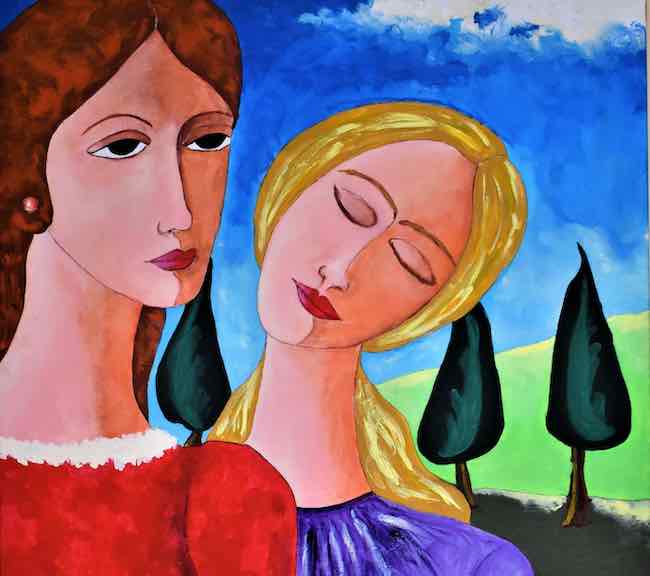Soffermarsi su tutto ciò che è parallelo alla realtà osservata, a quelle sensazioni ed emozioni che restano latenti nell’individuo, troppo impegnato nella quotidianità e nelle problematiche oggettive appartenenti al complesso vivere attuale, costituisce la linea espressiva di tutti quegli artisti che sentono il bisogno di trovare un mezzo per evadere, cercando un luogo migliore dove lasciarsi andare alla narrazione delle sensazioni ed emozioni più spontanee, più pure, più legate a un mondo fiabesco e sognante che non a quello contingente tendente spesso a togliere all’individuo la poesia del vivere e l’attitudine a credere di potersi elevare verso qualcosa di migliore. La protagonista di oggi lega la sua produzione pittorica a un’immediatezza espressiva che conquista l’osservatore trasportandolo in un mondo più semplice.
Il ritorno alla genuinità, a un’essenzialità dell’immagine funzionale a focalizzare l’attenzione sul sentire, sulle emozioni piuttosto che sull’estetica e la perfezione della forma, fu l’obiettivo principale dei Fauves che tracciarono le linee guida del successivo movimento evoluzione di quel preludio di cambiamento, l’Espressionismo. Il tratto descrittivo contraddistinto da contorni netti, l’assenza di prospettiva e di chiaroscuro, l’eliminazione della tridimensionalità e il rifiuto della gamma cromatica più attinente alla realtà indussero gli ambienti culturali e artistici dell’epoca a scandalizzarsi davanti a uno stile tanto primitivo ed esemplificativo dell’osservato, al punto di attribuire a Henri Matisse, André Derain e Maurice de Vlaminck l’appellativo di bestie, fauves in francese. Malgrado le resistenze e le opposizioni altri artisti decisero di seguire e ampliare quelle linee teoriche poiché intravedevano in quelle nuove possibilità il modo per lasciar emergere quel mondo emozionale trascurato dai movimenti pittorici precedenti più focalizzati sulla perfezione esecutiva, il Realismo, o sulla bellezza e l’aderenza alla realtà osservata attraverso l’utilizzo di luce e frammentazione del colore, l’Impressionismo. Dunque il nuovo movimento accolse autori diversi che personalizzarono lo stile sulla base del loro sentire, della loro attitudine interiore e anche secondo la parte delle proprie emozioni su cui volevano focalizzarsi; dalle opere inquiete e deformi di Oscar Kokoshka alle tele sensuali e disarmanti di Egon Schiele, passando per l’ironia pungente di Ernst Ludwig Kirchner per giungere all’Espressionismo francese, quello in cui venne mantenuto un legame più stretto con il sogno, con l’idillio nascosto nelle pieghe della realtà, con il bisogno di evasione attratto dal fascino dell’esotico. Marc Chagall, Paul Gauguin ed Henri Matisse raccontarono ciascuno a proprio modo un’esigenza interiore di interpretare il mondo secondo il loro particolare punto di vista, più idilliaco e quasi morbidamente magico quello di Chagall, più orientato alla fuga da una realtà ormai troppo distante dal suo desiderio esistenziale quello di Gauguin, e infine più alla ricerca della semplicità, all’esaltazione emozionale delle piccole cose quotidiane quello di Matisse. L’artista laziale Loredana Giannuzzi si avvicina alla poetica di Chagall mescolandola con quella di Matisse per dare vita a uno stile personale, delicato e al tempo stesso intenso, attraverso cui suggerisce un approccio differente alla realtà osservata, quello più puro, più spontaneo, grazie al quale possono emergere le sensazioni che legano l’emotività a un ricordo, a un dettaglio che ha catturato la sua attenzione oppure a un sogno, un desiderio che tutto sia come nelle favole, idilliaco e armonioso.
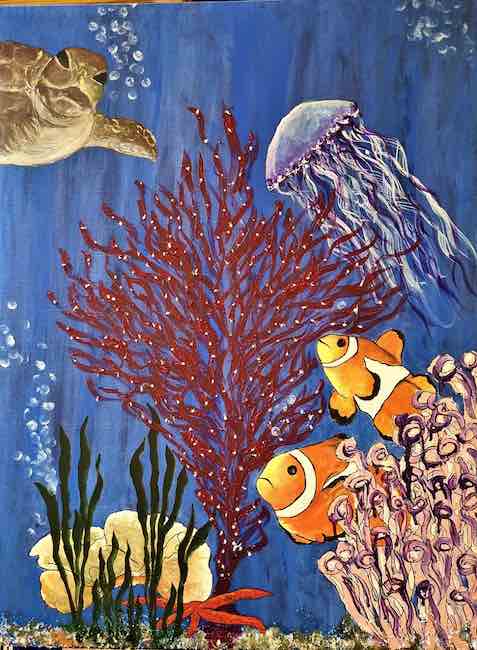
Le sue opere oltrepassano il confine del reale e rendono possibile un mondo diverso affollato di fondali marini, di personaggi leggendari oppure di frangenti di esistenza fotografati dalla sua memoria emotiva e poi narrati con tocco delicato sulla tela; la gamma cromatica è piena, vivace, esattamente come da linee guida dell’Espressionismo, genere pittorico a cui indiscutibilmente appartiene, e presenta sempre quel tocco di positività, quello sguardo sorridente che le permette di osservare il mondo come se si trovasse all’interno di una favola, di un racconto fanciullesco in cui esistono solo i sentimenti buoni, quelli che permettono all’essere umano adulto di riuscire a guardare la realtà con gli occhi di un bambino.
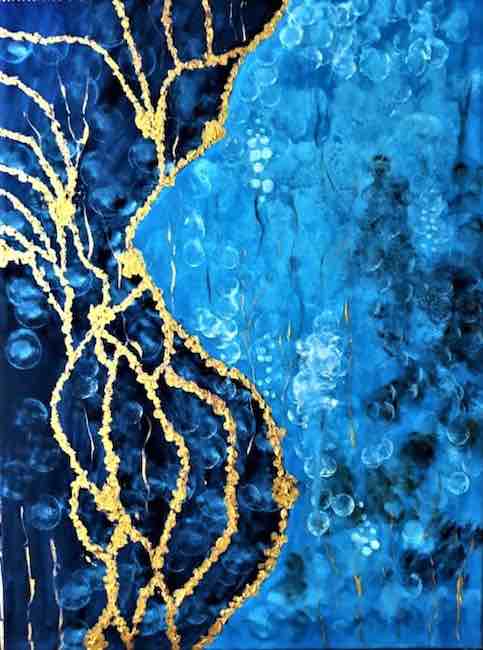
La sua capacità di elevarsi dal contingente e di trascinare l’osservatore nel suo mondo incantato le permette di reinterpretare significati che appartengono alla realtà attuale, di spostarli e donargli una svolta differente, una nuova possibilità che non potrebbe essere ottenuta nelle complesse pieghe del vivere contemporaneo; il compito dell’arte nel suo caso non è quello di essere testimone degli eventi, e neanche quello di oltrepassare tutto ciò che è visibile distaccandosi completamente dall’immagine bensì quello di essere in grado di elevare verso quell’armonia che nella quotidianità sembra irraggiungibile.
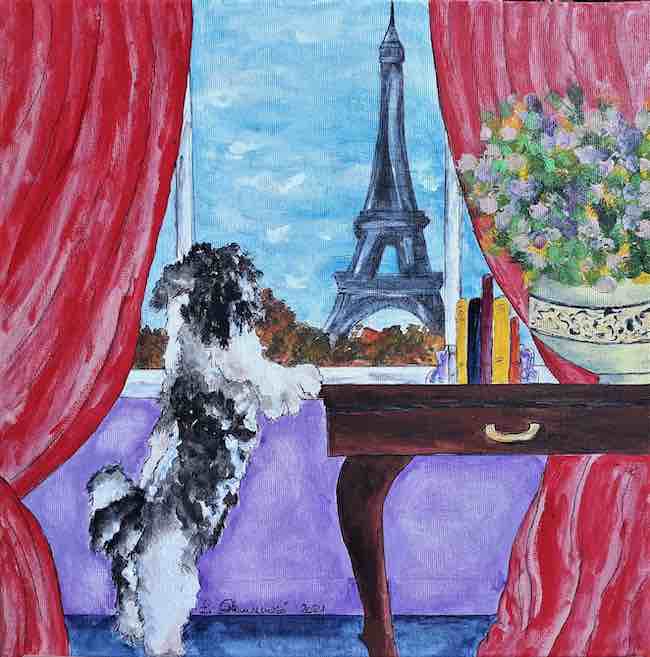
Dunque una sorta di evasione poetica quella di Loredana Giannuzzi, una dimensione ideale dentro la quale rifugiarsi e sognare tutto ciò che non può essere concretizzato oppure ciò che è stato concretizzato ma poi si è allontanato; nell’opera Fuori dalla finestra evidenzia un frammento di piacevole realtà, un viaggio a Parigi, in cui il cagnolino sembra guardare il paesaggio davanti a sé con lo stesso entusiasmo di un essere umano, mentre il punto di osservazione è esterno all’opera, come se l’artista volesse imprimere sulla tela tutto l’affetto per quel compagno di viaggio e di avventure, sottolineandone l’aspetto emotivo, divertito, curioso, rendendolo pertanto il vero protagonista del quadro. I colori intensi del muro, delle tende e del pavimento sono cornice perfetta della vivacità dell’unico elemento animato della composizione perché in fondo, sembra suggerire la Giannuzzi, dipende dal nostro approccio vedere le cose in scala di grigi o in multicolore.
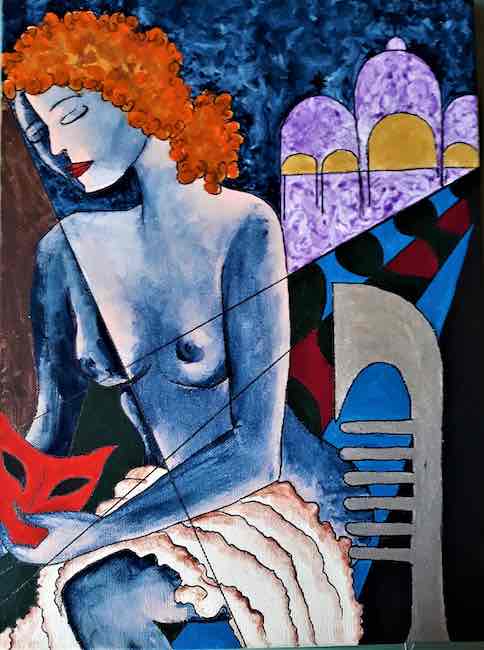
Nel dipinto Life is just a dream riproduce un altro ricordo, quello legato a Venezia città in cui si svolge uno dei Carnevali più famosi al mondo durante il quale tutto sembra un’alchimia, una magia fantastica dove tutto può succedere, e poi però oltrepassa il momento di festa e sceglie di immortalare il frangente successivo, quello durante il quale le maschere cadono e la protagonista si trova sola con se stessa a ricordare gli istanti più belli e aspettando emotivamente l’anno seguente per ricalarsi nella medesima emozione, in quello stesso sogno in cui ha potuto sentirsi una principessa, una dama, una regina, anche se solo per qualche giorno. Ecco il motivo del titolo, perché molto spesso, anche se è incapace di ammetterlo, l’essere umano vive di sogni, di desideri inespressi, di speranze inconfessate e dunque, sembra suggerire Loredana Giannuzzi, forse è meglio lasciarsi cullare da essi, permettere loro di entrare nelle nostre vite per renderle migliori, anche solo per il frangente in cui si chiudono gli occhi.
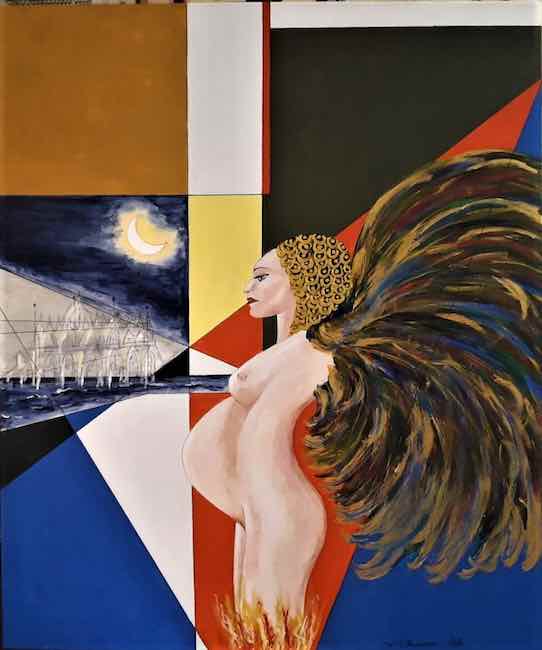
Nell’opera Fenice o la rinascita gioca con i simboli ma anche con l’arte perché da un lato fa l’occhiolino al De Stijl usandone la geometricità e i colori primari come sfondo della composizione, dall’altro richiama il teatro della città lagunare, La Fenice appunto, e poi mette in primo piano l’animale leggendario in grado di risorgere dalle proprie ceneri che lei identifica con una donna in dolce attesa, sottolineando quanto la figura femminile sia fondamentale in tutte le sue sfaccettature per la sua capacità di essere generatrice di vita ma anche propagatrice di emozioni, di forza, di determinazione, di consapevolezza delle proprie fragilità che ammette e trasforma in valore. Il simbolo si mescola al plasticismo e all’estetica per dare vita a un nuovo modo di intendere l’arte, quello che nel tempo si è inevitabilmente verificato e che ha testimoniato una continua rinascita dagli stili precedenti, che si sono mescolati creando inediti linguaggi.
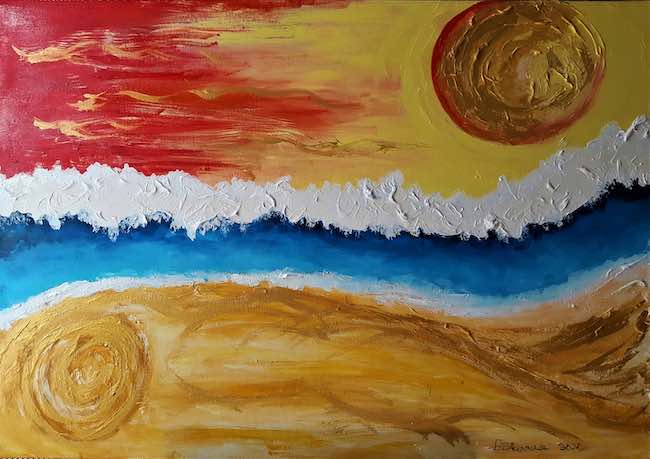
E poi si sposta quasi verso l’irreale in Vortice in un tramonto alle Egadi, dove il disco solare non si specchia nell’acqua agitata del mare di cui la Giannuzzi descrive solo la cresta ondosa, bensì nella sabbia, quasi l’energia del sole riuscisse a imprimersi sul bagnasciuga, scolpendo la sua immagine che si fissa nel ricordo dell’artista come dell’osservatore. Loredana Giannuzzi ha al suo attivo numerose mostre collettive sia in Italia che all’estero – Parigi, Oslo, Barcellona, San Pietroburgo, Londra -, ha vinto premi e riconoscimenti e le sue opere sono inserite in molti cataloghi di arte.
LOREDANA GIANNUZZI-CONTATTI
Email: deannatroy54@gmail.com
Sito web: https://www.artmajeur.com/loredana-giannuzzi
Facebook: https://www.facebook.com/loredanagiannuzziartista/
https://www.facebook.com/regina.croceneraiii
Instagram: https://www.instagram.com/loredanagiannuzzi7801/
The dreamy and poetic Expressionism of Loredana Giannuzzi, describing a serene and idyllic fairytale world
Dwelling on everything that is parallel to the observed reality, on those sensations and emotions that remain latent in the individual, too busy with everyday life and the objective problems belonging to today’s complex living, constitutes the expressive line of all those artists who feel the need to find a means of escape, looking for a better place where they can let themselves go to the narration of the most spontaneous, purest sensations and emotions, more connected to a fairy-tale and dreamy world than to the contingent one that often tends to deprive the individual of the poetry of living and the aptitude to believe they can rise to something better. Today’s protagonist binds her pictorial production to an expressive immediacy that conquers the observer, transporting him to a simpler world.
The return to genuineness, to an essentiality of the image functional to focus attention on feeling, on emotions rather than on aesthetics and perfection of form, was the main objective of the Fauves who traced the guidelines of the next movement to evolve from that prelude to changing, the Expressionism. The descriptive strokes characterised by sharp outlines, the absence of perspective and chiaroscuro, the elimination of three-dimensionality and the rejection of the colour palette more in keeping with reality led the cultural and artistic circles of the time to be scandalised by such a primitive style that exemplified the observed, to the point of calling Henri Matisse, André Derain and Maurice de Vlaminck beasts, fauves in French. Despite resistance and opposition, other artists decided to follow and expand on those theoretical lines as they saw in those new possibilities a way to let emerge that emotional world neglected by previous painting movements more focused on executive perfection, Realism, or on beauty and adherence to observed reality through the use of light and fragmentation of colour, Impressionism. So the new movement welcomed different authors who personalised their style according to their feelings, their inner attitude and also according to the part of their own emotions they wanted to focus on; from the restless and deformed artworks of Oscar Kokoshka to the sensual and disarming canvases of Egon Schiele, passing through the biting irony of Ernst Ludwig Kirchner to French Expressionism, the one in which was maintained a closer link with the dream, with the idyll hidden in the folds of reality, with the need for escape attracted by the allure of the exotic.
Marc Chagall, Paul Gauguin and Henri Matisse each in their own way recounted an inner need to interpret the world according to their particular point of view, Chagall’s more idyllic and almost softly magical, Gauguin’s more oriented towards escaping from a reality that was now too distant from his existential desire, and finally Matisse’s more in search of simplicity, the emotional exaltation of small everyday things. Loredana Giannuzzi, an artist from Lazio, approaches the poetics of Chagall, mixing it with that of Matisse to give life to a personal style that is both delicate and intense, through which she suggests a different approach to observed reality, one that is purer, more spontaneous, thanks to which can emerge the sensations that bind emotion to a memory, to a detail that has captured her attention or to a dream, a desire for everything to be like in a fairy tale, idyllic and harmonious. Her artworks transcend the boundary of reality and make possible a different world crowded with seabeds, legendary characters or fragments of existence photographed by her emotional memory and then narrated with a delicate touch on canvas; the chromatic range is full, lively, exactly as per the guidelines of Expressionism, the pictorial genre to which she indisputably belongs, and always presents that touch of positivity, that smiling look that allows her to observe the world as if she were inside a fairy tale, a childish story in which exist only good feelings, those that allow the adult human being to be able to look at reality with the eyes of a child. Her ability to rise above the contingent and drag the observer into her enchanted world allows her to reinterpret meanings that belong to current reality, to shift them and give them a different twist, a new possibility that could not be obtained in the complex folds of contemporary life; the task of art in her case is not to be a witness to events, nor is it to go beyond all that is visible by detaching itself completely from the image, but rather to be able to elevate it towards that harmony that seems unattainable in everyday life.
Therefore, Loredana Giannuzzi’s is a sort of poetic escape, an ideal dimension in which to take refuge and dream of all that cannot be realised or that which has been realised but then receded; in the painting Outside the Window, she highlights a fragment of pleasant reality, a trip to Paris, in which the little dog seems to look at the landscape in front of him with the same enthusiasm as a human being, while the point of observation is outside the artwork, as if the artist wanted to imprint on the canvas all the affection for that companion of travel and adventure, emphasising its emotional, amused, curious aspect, thus making it the real protagonist of the painting. The intense colours of the wall, curtains and floor are the perfect frame for the liveliness of the only animated element in the composition because after all, Giannuzzi seems to suggest, it depends on our approach to see things in greyscale or multicolour. In the painting Life is just a dream, she reproduces another memory, the one linked to Venice, the city where one of the world’s most famous Carnivals takes place, during which everything seems to be alchemy, a fantastic magic where anything can happen, but then she goes beyond the moment of celebration and chooses to immortalise the next event, the one during which the masks fall and the protagonist finds alone with herself, remembering the most beautiful moments and emotionally waiting for the following year to relive the same emotion, in that same dream in which she was able to feel like a princess, a lady, a queen, even if only for a few days.
This is the reason for the title, because very often, even if we are unable to admit it, human beings live on dreams, on unexpressed desires, on unconfessed hopes and therefore, Loredana Giannuzzi seems to suggest, perhaps it is better to let ourselves be lulled by them, to allow them to enter our lives to make them better, even if only for the moment when we close our eyes. In the canvas Fenice or Rebirth she plays with symbols but also with art because on the one hand she winks at De Stijl by using its geometricity and primary colours as the background of the composition, on the other hand she recalls the theatre of the lagoon city, La Fenice, and then she puts in the foreground the legendary animal capable of rising from its own ashes that she identifies with an expectant woman, emphasising how fundamental the female figure is in all its facets for her capacity to be a generator of life but also a propagator of emotions, of strength, of determination, of awareness of one’s own fragility which it admits and transforms into value. Symbolism mixes with plasticism and aesthetics to give life to a new way of understanding art, one that has inevitably occurred over time and that has witnessed a continuous rebirth from previous styles, which have blended to create new languages. And then she moves almost towards the unreal in Vortex in a sunset at the Egadi Islands, where the sun disc is not reflected in the agitated water of the sea of which Giannuzzi only describes the wavy crest, but in the sand, almost as if the sun’s energy were able to imprint itself on the shoreline, sculpting its image that is fixed in the memory of the artist as well as the observer. Loredana Giannuzzi has numerous group exhibitions both in Italy and abroad – Paris, Oslo, Barcelona, St. Petersburg, London – to her credit, she has won prizes and awards and her artworks are included in many art catalogues.


